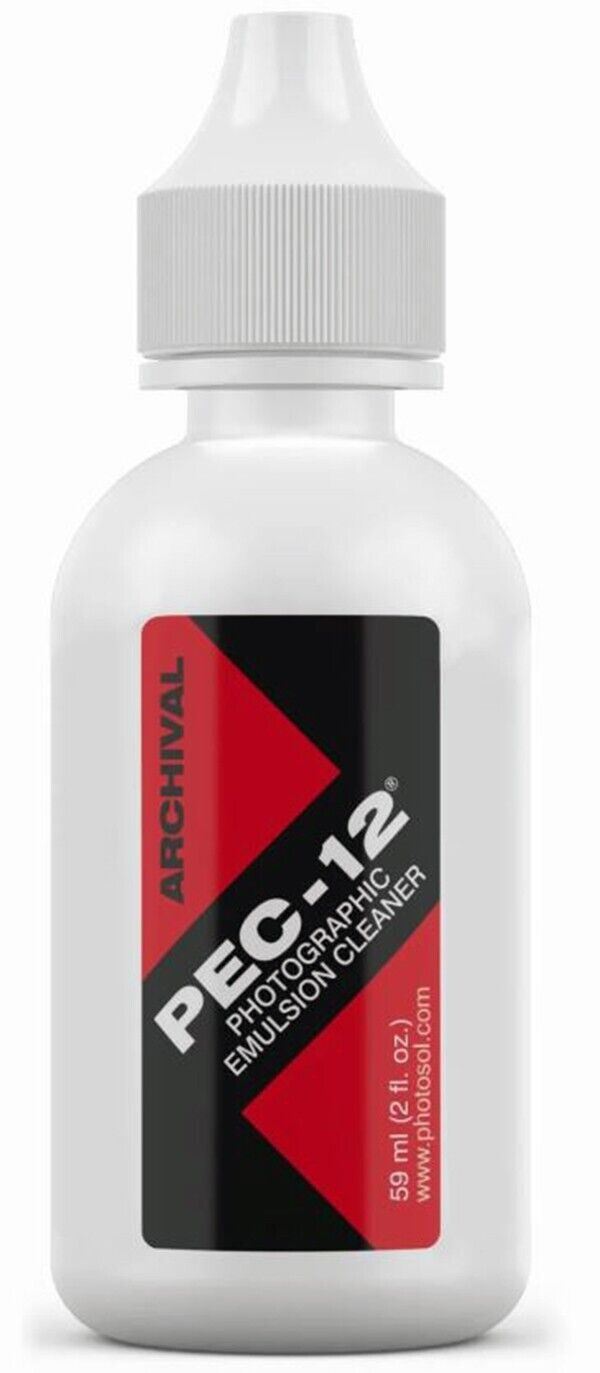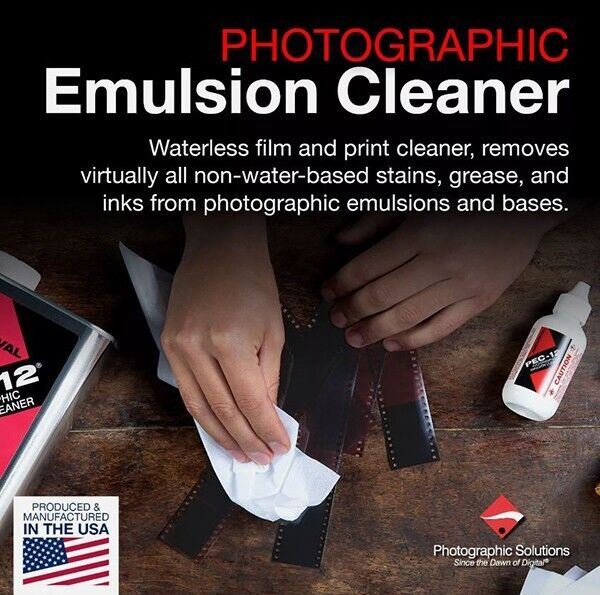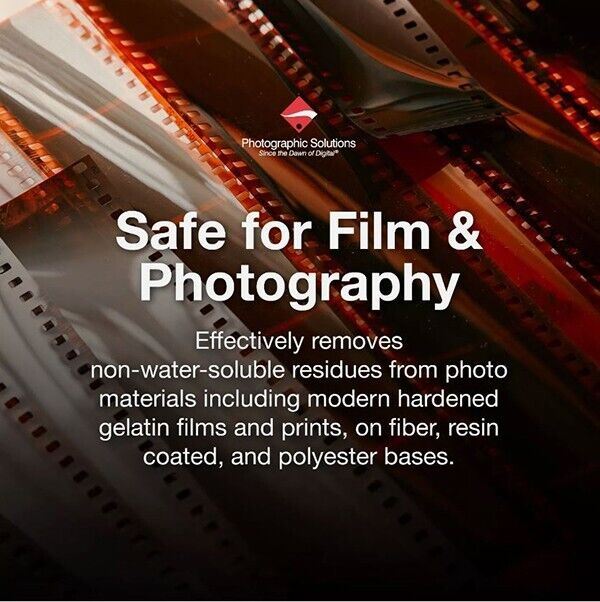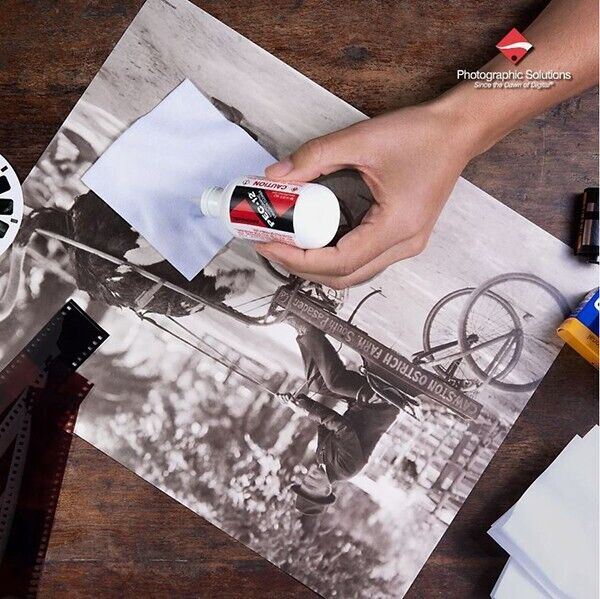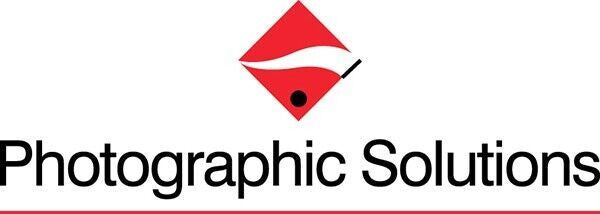1
/
of
5
Photographic Solutions
Photographic Solutions PEC-12 Film Emulsion Cleaner 2oz Negative Cleaning Fluid
Photographic Solutions PEC-12 Film Emulsion Cleaner 2oz Negative Cleaning Fluid
Regular price
£17.49
Regular price
Sale price
£17.49
Unit price
/
per
Taxes included.
Couldn't load pickup availability
Photographic Solutions PEC-12 Film Emulsion Cleaner 2oz Negative Cleaning Fluid
Brand New UK Stock, in original packaging with full Guarantee
What is PEC-12® ?
PEC-12® is a waterless Photographic Emulsion Cleaner which is suitable for use on most film and print emulsions. It is a blend of organic hydrocarbon solvents with a neutral pH and is free from chlorofluorocarbons and chlorinated hydrocarbons. It dries instantly, leaves no residue and meets archival needs. Because it contains no water, PEC-12® will not cause emulsion swelling, tackiness, water marks or other damage associated with re-washing.
PEC-12®is designed to remove non-water based stains, grease and inks from photographic emulsions and bases. It removes finger oils, grease pencil, adhesive tape residues, mildew, smoke and soot damage, gold foil stamp and most ball-point and permanent inks. It will aid in the removal of firmly affixed adhesive tape. Graphic arts applications include the easy removal of wax and rubylith.
How safe is PEC-12®?
PEC-12® is safer to use than most other hydrocarbon solvents. It contains no halogens which cause ozone damage and no known or suspected carcinogens. It is less hazardous to health than solvents used in office copier toners. It is also less toxic than many organic solvents found in the typical home. PEC-12® is extremely stable and has an indefinite shelf life when kept in its original capped container.
Like most solvents, PEC-12® is flammable. It must be kept away from open flames and sparks. Do not use in any areas which lack adequate ventilation. Individuals with asthma or other breathing difficulties should avoid inhaling PEC-12® or any solvent vapors. While excessive inhalation may cause dizziness and nausea, a headache will be experienced long before these more serious symptoms occur. At the first sign of a headache, discontinue use and seek fresh air. A headache is also an indication that the ventilation in use is inadequate for ANY darkroom use!
PEC-12® is hygroscopic. It will absorb moisture from the air if left uncapped. This will be evident if PEC-12® begins to wet and swell an emulsion. Discard immediately, by placing the open container outside until it has evaporated. Because PEC-12® is effective at removing finger oils from photographic emulsions, it is only natural that it will dissolve these oils from your skin! This can cause irritation and rashes in individuals with sensitive skin but otherwise will cause only mild dry skin after continued and prolonged exposure. Those with chronic skin conditions, such as eczema should avoid direct contact with PEC-12® for this reason. It will sting open cuts or abrasions. A good quality plastic examination glove should be worn to avoid skin contact should any difficulty be experienced.
On what can PEC-12® be used?
PEC-12® has been tested by an independent organization concerned with photographic preservation. It found that PEC-12® will not cause any hidden or long term damage to photographic images. It has no adverse effects on long term B&W or color image permanence or on dye stability.
Copies of these findings are available upon request. Beware of products sold for cleaning photo materials which contain peroxide formers. These chemicals react with any moisture in the air to form hydrogen peroxide, a strong bleaching agent which can irreparably destroy (by bleaching out) an emulsion. (The real danger with these products is that by the time the damage is discovered, it’s too late to save the image.)
PEC-12® will damage certain materials such as non-hardened gelatin or albumen emulsions and many dye-sublimation materials. Care should be taken whenever using this product on a print or film of unknown nature, including older B&W and newer B&W processed by “Fine Art” photographers. A safety test should be done on each print or film emulsion as described under the heading “When NOT to use PEC-12®”.
When to use PEC-12®?
It will remove a wide variety of non-water-soluble residues from photo materials, leaving them grease, oil and ink-free. Among the materials on which PEC-12® can be safely used are: All modern hardened gelatin films, both B&W and color (including, but not limited to C-41, E-6 and K-14 processes); All modern hardened gelatin prints, both B&W and color, on fiber, resin coated, and polyester bases. This includes prints made with EP-2, RA-4 and Ciba (Ilfo)chrome processes.
PEC-12® should be used sparingly; a little bit goes a long way. In most cases, there is no need to apply it directly onto the photo or film. Apply a drop or two onto a PEC*PAD® Non-abrasive Wipes, cotton swab or pad. Don’t drench the applicator with PEC-12® which will waste the solution and will not increase effectiveness. If excessive amounts are applied to an emulsion, there may be a white haze left on the surface when the PEC-12® evaporates. The haze is not harmful and can be easily removed by using a new applicator with less PEC-12®. (The haze doesn’t generally appear on prints, and if it appears on a slide/negative, it won’t generally print.)
For working on larger films or prints, use the larger size PEC*PAD® or similar applicator. When using a PEC*PAD®, simply wipe it across the film/print. (See the PEC*PAD® specifications for complete instructions.) If using other applicators wipe the film lightly, turning the applicator to carry away the grime and bring clean PEC-12® to the emulsion. These other applicators will also require a final wipe with a clean applicator lightly moistened with PEC-12® to remove any lingering residue. The pad itself should look clean after this last application. In some instances, with slide or negative films, one may notice a slight coloring usually magenta (prints) or yellow/green (slides) being removed from the film and discoloring the applicator. This occurs because during processing the final wash tank was not supplied with adequate fresh running water allowing chemical carryover contamination. Any film passing through this wash is thus “contaminated” with residual chemicals. PEC-12® is removing this residual contamination from the film and actually improving image quality and permanence!
PEC-12® dissolves only non-water based stains. If it is going to work on a particular stain, it will do so immediately. If there is no immediate effect, DON’T apply any pressure to the print or film. That won’t work any better, and non-PEC*PAD® applicators can scratch the image. An exception to this is cleaning adhesive residues, which may require several applications, a heavier dose of PEC-12®, or a combination of both. But DO NOT RUB HARD in attempting removal.
When cleaning anti-scratch laser-separation oil, use PEC*PAD® to remove any excess before applying PEC-12®. The preferred method for cleaning film of these contaminants is to pour an ounce or so of PEC-12® into a very small tray or Petri dish. Immerse the film completely in the PEC-12®, agitate LIGHTLY, and remove it after a few seconds. CAUTION: Films immersed in PEC-12® for extended periods (several hours or more) may develop an excessive reverse curl. This method should also be used when removing lacquer from film (such as found on Kodachrome processed before 1970). Repeat this process of soak/agitate/wipe until all the oil, lacquer or adhesive has been removed. When the film dries there will remain the haze that results from over-application of PEC-12®, which can be wiped off with a PEC-12® treated PEC*PAD®. You can save the PEC-12® from this dish for future use (in cleaning the same contaminant) in a separate bottle. NEVER put used PEC-12 back into a container with unused PEC-12®.
PEC-12® is an excellent solvent for removing non-water-based inks and retouching dyes. Before applying it to a print or film, determine that the underlying work surface is not covered with paint or inks which are soluble in PEC-12®. For example, the printed colors and text on most photographic film or paper boxes will dissolve in PEC-12®; they could be picked up by stray solvent and stain the photo being cleaned. It’s safest to work on an un-dyed and unpainted work surface when cleaning a film or print with PEC-12®. Sheets of clean, white, acid free paper or museum board are ideal.
PEC-12® will remove retouching colors if they are oil-based, and will have a minimum effect on water-based retouching dyes by removing only whatever dyes may be on the surface.
You might consider a switch to pens and ink pads which are removable by PEC-12®. Throw out any pens and ink pads which cannot be removed by PEC-12®. This will provide a safe and reversible means to mark prints/film and insure against accidental, permanent damage. (Should a customer bring in a stained print or film, PEC-12® may remove it if the stain isn’t water-based. If you can clean it, you’re a hero, if you cannot, the stain wasn’t your fault to begin with.) This is why it’s important to use only inks you know are PEC-compatible. Ink manufacturers may periodically reformulate their inks, so test your pens and pads regularly to make sure they are still PEC-compatible before marking up a job.
Removing mold, mildew, fungus:
PEC-12® will remove mold, mildew and fungus and will do so very easily and very little pressure is needed. They grow on photographic emulsions when film or prints are stored with any humidity in the air, and especially if stored images were subjected to any flooding. These organisms actually live by eating the gelatin emulsion which is also what creates the image. So after removal, it may be that you see very little image damage to no image at all. It is not the PEC-12® that destroyed the image – it was the organisms.
It is strongly recommended that when cleaning off mounted
transparencies that you remove them from the mount to be sure you can wipe clean the entire piece of film of all growth. Otherwise, organisms are going to be swept under the mount and may reappear. Once cleaned, be sure and store images in a cool dry location.
Cleaning motion picture film:
PEC-12® can be used to clean motion picture film when used as previously described. It is best applied when the film can be rolled from one reel to the other holding a folded PEC*PAD moistened with PEC-12®. If you do, be careful that you do not trap grit that will then scratch as you continue to pull film through the PEC*PAD®. Check the PAD often and replace at slightest hint of anything foreign on it ! Note the caveat regarding mold removal in the above paragraph. PEC-12® may also dissolve some splicing solvents or other adhesives if left in contact for extended time, so use caution.
POLAROID ® IMAGE CLEANING:
There are many types of these films covering a span of several decades, but all discontinued long ago. Other than SX-70 prints, none of the earlier images are likely to be ID’s as to film type, age, etc. Some of the earliest are the deckle-edged b&w images which required a coating to be applied as soon as the image had fully developed. Then there were the color images which also required the coating. The SX-70 films can be gently wiped with PEC-12 with safety, as these films are coated with a protective layer covering the actual emulsion. The early b&w and color prints will require careful testing for EACH AND EVERY image, as detailed elsewhere in the info pages for PEC-12. If this cleaning is to be successful, it must be done extremely quickly in a single pass to remove surface grime but not dissolve the coating. Removing this coating – but not the underlying image – is almost impossible to achieve repeatedly.
It may be best – and safest – to just copy the image and use editing software to remove offending marks.
When NOT to use PEC-12®:
Unhardened or inherently soft emulsions such as inkjet or dye-sub prints, chromogenic films, dye transfer matrix film, albumen, glass plate emulsion, and Polachrome instant slide film should NOT be cleaned with PEC-12®. Chromogenic film is usually marked as such, but not always. For example, B&W film intended for color C41 processing are chromogenic. Some Velvia emulsions may not be suitable for PEC-12®, while other Velvia emulsions are PEC-compatible. Never use PEC-12® on plastic optics or compound lenses of any kind, including camera and enlarging lenses. PEC-12® may cause irreparable damage to such optics by dissolving adhesives or cements used in their construction. (For lens cleaning use our Eclipse® Optic Cleaning Fluid or Aeroclipse® Optic Cleaning Fluid with PEC*PAD®).
PEC-12® should only be used on photographic materials as specifically intended.
Neither albumen nor unhardened gelatin is commonly found in modern silver halide based films or papers, although they may occur in older or ‘alternative’ processes. In any such cases where doubt exists, test PEC-12® on an unimportant corner of it, preferably outside of the image area (border). Dab the border with a corner of a PEC*PAD® which has been lightly moistened with a small amount of PEC-12®. If the solution is going to cause any damage, it will do so immediately by removing the emulsion at that point and create a stringy egg-white-like blob as the PAD is pulled away from the print. If the emulsion is not damaged after a light wipe, PEC-12® will be safe to use. It is important to note that any damage will occur IMMEDIATELY on contact. DO NOT RUB HARD as that WILL cause permanent damage! The only possible exception is with computer generated dye-sublimation prints, which may withstand an initial wipe with PEC-12®, but will smear after a few seconds. It is best to avoid using PEC-12® on these types of prints because of the uncertainty.
CAUTION: Several companies are selling products claiming to provide the same results as PEC-12®, and are using very similar product names, packaging, and have even copied text from our brochure. DO NOT BE MISLED! We stand behind the quality of our product which was first used in 1971. After twelve years and extensive testing, PEC-12® was introduced commercially in 1983. Since then, it has been widely used and endorsed by some of the most respected names in the photographic industry. PEC-12® is also the ONLY cleaner tested by a leading image preservation research institute and their report clearly shows that PEC-12® causes no “major ill effects in the short term . . . or in the long term” under the conditions and with the materials tested (report available on request.)
Share
